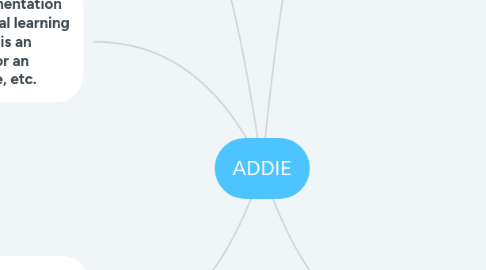
1. Develop: During the development phase, the instructional designer takes the information created in the design phase and uses it to actually create the end product in detail.
1.1. Develop Instruction
1.1.1. What are all the steps and details of instruction within the activities?
1.1.1.1. How will the students get enough practice?
1.1.2. How will the instruction be delivered?
1.2. Create Media
1.2.1. What types of media need to be developed?
1.2.1.1. What should the visual theme be?
1.2.1.2. What needs to be written?
1.2.1.2.1. What should be the tone of the writing?
1.2.1.3. How is technology integrated into the instruction?
1.2.1.3.1. What needs to be developed?
1.2.2. Do prototypes need to be created?
2. Implement: The implementation phase is when the actual learning happens, whether that is an instructor presenting, or an online course going live, etc.
2.1. Preparation
2.1.1. Do any trainers need to be trained on how to implement the instruction?
2.1.2. What information about the details of the training do the learners need ahead of time?
2.1.3. What locations and resources need to be prepared before the training?
2.1.3.1. If the learners are together in a physical space, what seating arrangement is most conducive to the type of learning that will happen?
2.2. Instruction
2.2.1. Implement the instruction according to plan.
3. Evaluate: The evaluation process happens both throughout all the other phases and at the end. The purpose of evaluation is to refine the learning and to make sure that it accomplishes what it is meant to accomplish.
3.1. Formative Evaluation
3.1.1. How well are the objectives being met within the instruction?
3.1.2. Are the solutions suitable for the learners?
3.1.3. Does the instruction flow logically?
3.2. Summative Evaluation
3.2.1. What were the learners' impressions of the instruction?
3.2.1.1. How engaged and motivated were the learners?
3.2.2. How well did the learners succeed in meeting the learning outcomes?
3.2.3. What are the learners able to do after the instruction that they weren't able to do before?
3.2.4. Did the instruction meet the original goals and solve the original problem?
4. Analyze: The analysis phase is when an instructional designer takes a careful look at the need for training and gathers information that will help form the backbone of the instruction.
4.1. Goals
4.1.1. What is the problem that needs to be solved?
4.1.2. Is learning a solution to solve that problem?
4.1.3. What are the ultimate performance goals?
4.2. Needs Analysis
4.2.1. What do the learners need to do?
4.2.2. What is the gap between what they are doing and what they need to do?
4.2.3. What needs to happen to bridge that gap?
4.3. Learner Analysis
4.3.1. Who are the learners?
4.3.1.1. What are the learner demographics?
4.3.1.2. What do the learners care about?
4.3.1.3. What are the learners' motivations?
4.3.2. What do they know?
4.3.2.1. What is the range of knowledge and experience within the group?
4.3.3. What do they still need to know?
4.4. Task Analysis
4.4.1. What needs to be done?
4.4.2. What are the steps?
4.4.3. What needs to happen in order to do the steps?
4.4.3.1. What resources are needed?
4.4.3.2. How much will it cost?
4.4.3.3. How long will it take?
5. Design: The design phase is when the instructional designer forms the learning objectives and outlines the elements of the instruction around those.
5.1. Objectives
5.1.1. What should learners be able to do after training?
5.1.1.1. What action should they take?
5.1.1.2. How well do they need to do it?
5.1.1.3. Under what circumstances should they do it?
5.2. Developing Assessments
5.2.1. What kind of assessment would best allow the learner to demonstrate what they need to perform?
5.2.2. What level of performance shows that the learner mastered the skill/knowledge?
5.3. Scope and Sequence
5.3.1. What is the best logical order for the learners to work through the objectives?
5.3.2. How basic or advanced should the content be?
5.3.3. What are the prerequisites for the learners?
5.4. Activities
5.4.1. What kinds of activities would best teach the knowledge/skills?

